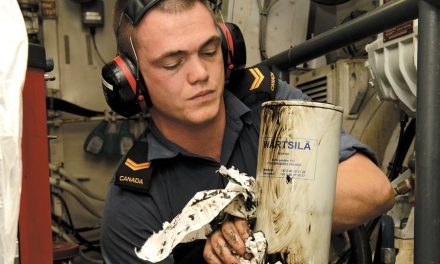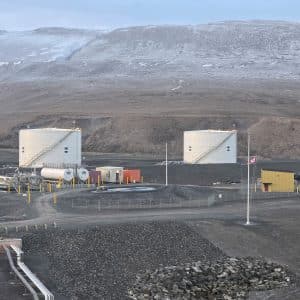DND — Defence science and technology, led by Defence Research and Development Canada (DRDC), is helping the Canadian Armed Forces (CAF) understand, monitor, reduce and mitigate its impact on the marine environment during operations.
DRDC is taking a multi-disciplinary, multi-pronged approach working with partners in industry, academia and other government departments to develop innovative solutions that benefit the marine environment and CAF operational capabilities.
An example of the type of innovative research is the work of Layton Gilroy and Matthew Gauthier, defence scientists at DRDC Atlantic Research Centre. In collaboration with Transport Canada, and as part of their Quiet Vessel Initiative, they’re researching a quieter propeller to reduce ocean noise.
Propellers rotating at higher speeds can create bubbles or cavities in water called “cavitation”. When the bubbles “pop”, the implosions can damage nearby surfaces and significantly increase underwater noise. A “cavitating” propeller is generally the loudest noise source on a ship.
The researchers set out to increase the ship speed at which cavitation begins, known as “cavitation inception speed”.
The faster a ship can go before cavitation begins, the less time spent operating with a cavitating propeller and the less the overall noise will impact the environment.
“Understanding how to increase cavitation inception speed in propeller design is a win-win for the Canadian Armed Forces as it reduces impacts on whales and makes RCN ships less detectable and may extend the life of propellers,” Gilroy said.
The Royal Canadian Navy’s ORCA-class training vessels were selected for this research because the results can be used for both naval and civilian ocean noise reduction goals as the ships are commercially constructed and data from the research is unclassified.
To design a quieter propeller, DRDC worked with its international partners to analyze the propeller and ship numerically and to build a 1:7 scale model of the vessel. Numerical studies were performed to design a propeller, which would cavitate at a much higher ship speed and then the model-scale propeller was tested in a towing tank. The new design showed significant potential improvement of about five knots in the cavitation inception speed. This research is now ready to advance to a full-scale trial.
If successful, the quieter design could have implications beyond the Royal Canadian Navy and reduce overall ocean noise.
Gilroy has also been using the technology to monitor the underwater noise of naval vessels to allow civilian ships to monitor their noise levels. Trials with an ORCA-class vessel at Patricia Bay, British Columbia, were performed to measure onboard vibrations as well as radiated noise. This database can be used to predict underwater noise using onboard sensors in real time. A simpler system could be installed on civilian ships to both monitor when cavitation begins and the resulting noise levels.















